|
|
| Sail Panel Vinyl Installation Step-by-Step |
914 Sail Panel Vinyl Installation Step-by-Step
As the newest Porsche 914 model approaches its thirtieth birthday, its passionate owners find
themselves in a battle with time and the elements. One of the standard wear items that can show poorly on a
914’s exterior is the sail panel vinyl that was so fashionable back in the 1970’s. Sun and time can take its
toll on the vinyl and the adhesive used to keep it in place.
I searched to no avail for a step-by-step on installing sail panel vinyl. I found people who had
done it, but no detailed instructions to give you an idea of what’s involved and/or a list of the tools needed
to perform the task. This is a “big” job when done right. You’ll have a good portion of your car torn apart, so
plan on a weekend without it. You’ll probably need to prep one day and assemble the next. Here’s a little how
to on what it will take to get your sail panel vinyl back to new.
Tools and Supplies:
- Phillips Head Screwdriver – Medium
- Phillips Head Screwdriver – Small
- Flat Head Screwdriver – Medium
- 8mm Socket with Long Extension
- 10mm Socket
- 17mm Socket
- Small 1 inch Putty Knife
- Utility Knife with Plenty of Sharp Blades
- Blue Masking Tape
- Regular Masking Tape
- Roll of Butcher Paper (or a bunch of newspapers)
- Spray Trim Adhesive
- Adhesive Remover
- Sail Panel Vinyl Kit (various vendors)
- Kitchen Timer/Alarm
- Spray Silicon (for inserting the window seals back in their trim)
Step 1: Remove Trim
You’ll obviously need to take off all the anodized aluminum trim pieces that cover the vinyl
before digging into this task. Remove the Targa top and start with the large pieces at the back of each sail
panel. You’ll want to remove the rear wheel to access the 8mm nut underneath the car. This holds a clip that
pulls the trim piece tight to the body at the base. There is one other mount at the top; a simple phillips head
screw. The long piece along the back of the roll hoop should pull off after these are removed. Next would be
the front of the sail panels where you’ll need to remove the rubber weather strip at the back of the door window
glass and then remove the mounting track. Remove the phillips head screws and then use the putty knife to slide
under the trim piece. You’ll find they are tacked on to the body with a sticky tar like (butyl tape) substance.
Work your way through the task of unscrewing the remaining pieces.
Step 2: Remove Interior Pieces and Vinyl
Remove your seats and your back pad. There are a couple large phillips head screws at the base
on each side of the pad. Once those are removed you’ll pull the pad out at the base, slide it down and out.
Next you’ll remove the interior pads around the rear window and underneath the top of the roll hoop. To do that
you’ll need to remove the seat belt mounts using the 17mm socket. Next it’s the coat hangers (has anyone ever
used these?) slip the plastic covers up to reveal the screws holding them in place. Finally, get all the trim
screws hiding under all the little black caps (of which you probably have a few missing…). Once you get the side
pieces off the roll hoop pad is next. Check the bottom of the pad, as there’s more screws and caps hiding
there. Remove the rear latches with the 10mm socket. Need to reseal your back window? Now would be a great time.
At this point you’ll want to make a mental note or even take a few pictures of where the folks at the factory
had trimmed the vinyl. Now simply peel off the old vinyl. It should come easily.
Step 3: Prep
Prep is the most important part to any good job. Once you’ve got everything off you’ll need to
prep the car and the surface that you’ll be working on. To prep the car I used the 3M “Blue” tape that is paint
friendly on the body and then tapped butcher paper ($16.00 for a roll that should last you a lifetime) to mask
it off using the regular masking tape. The adhesive sprays in a definite pattern but it’s best to have
“everything” masked off so you don’t get unwanted overspray on your interior or paint. Final prep involves
cleaning the work surface and removing all the old adhesive (don’t skip this important step.) You’ll especially
want to make sure the corners of the roll hoop are clean as the vinyl will have to be bent and somewhat
stretched a bit to adhere. Clean, clean, and then clean some more. Use the adhesive remover and make sure the
entire area is clean. I performed a final wipe down with acetone. Next, you’ll want to test fit your vinyl so
you know where it’s going during the heat of battle better known as the final installation.
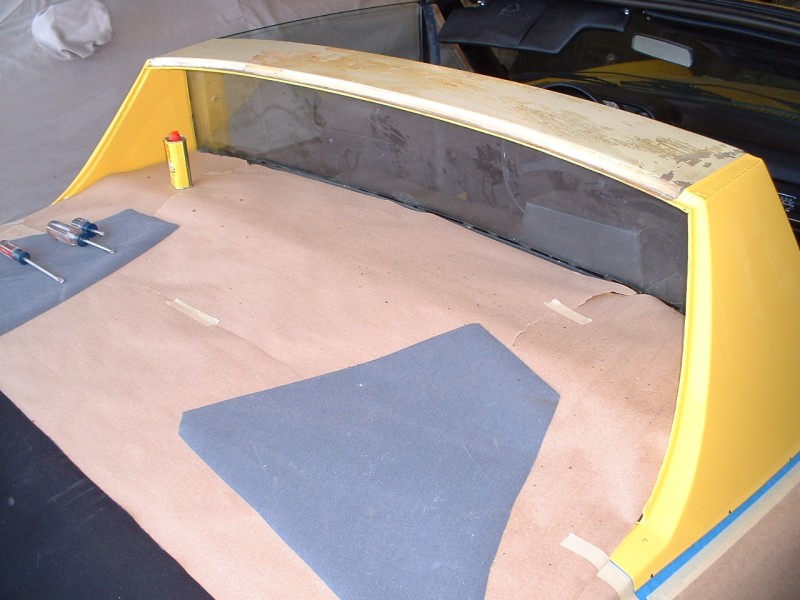
Area taped off and ready for clean
up.
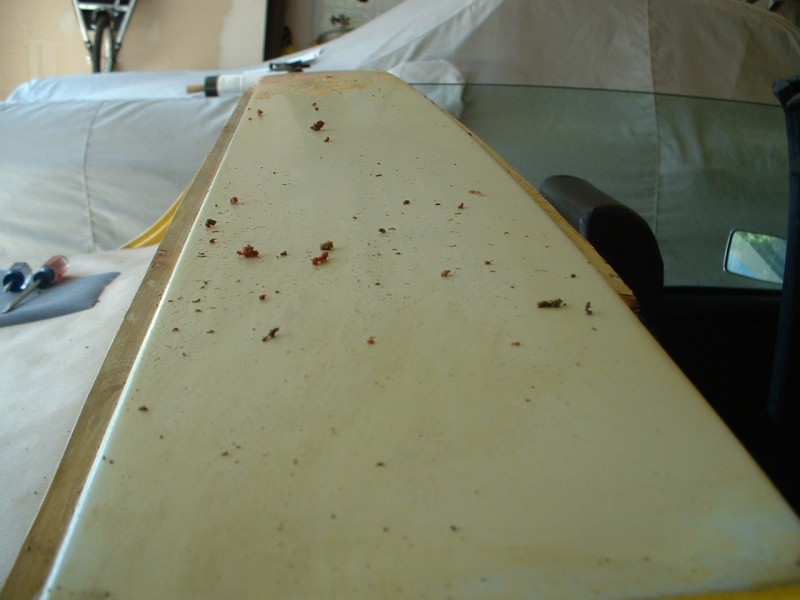
Old adhesive
rolling up as the solvent strips it off the car.
Step 4: Spraying on the Adhesive
It all goes very fast at this point so you should be well prepared and ready to race the clock.
You need to have an area where you can spray the backside of the vinyl. I used the butcher paper and covered the
entire rear deck lid. It’s an excellent area to lay down the pieces. The adhesive is sprayed on in two coats on
each area (car and vinyl). Each coat goes in a different direction (left to right and then up and down) to
ensure even coverage.
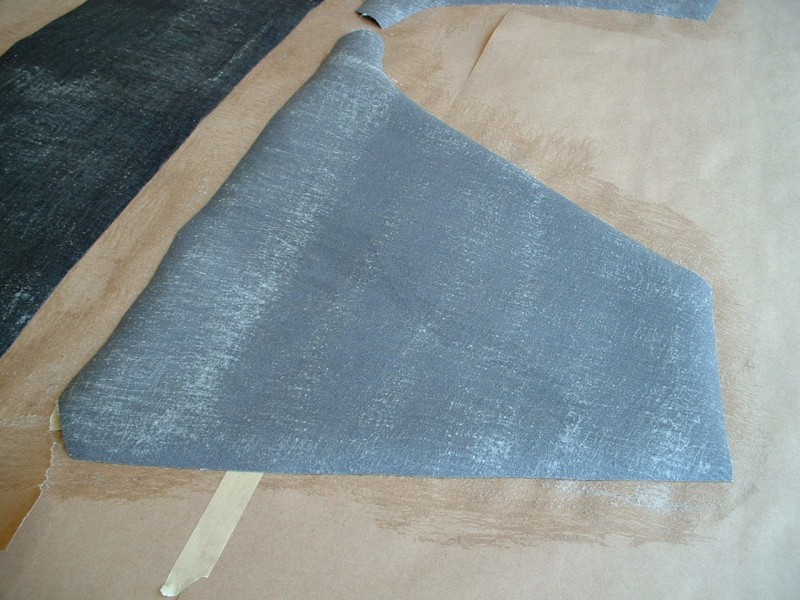
Adhesive on the back of the
vinyl.
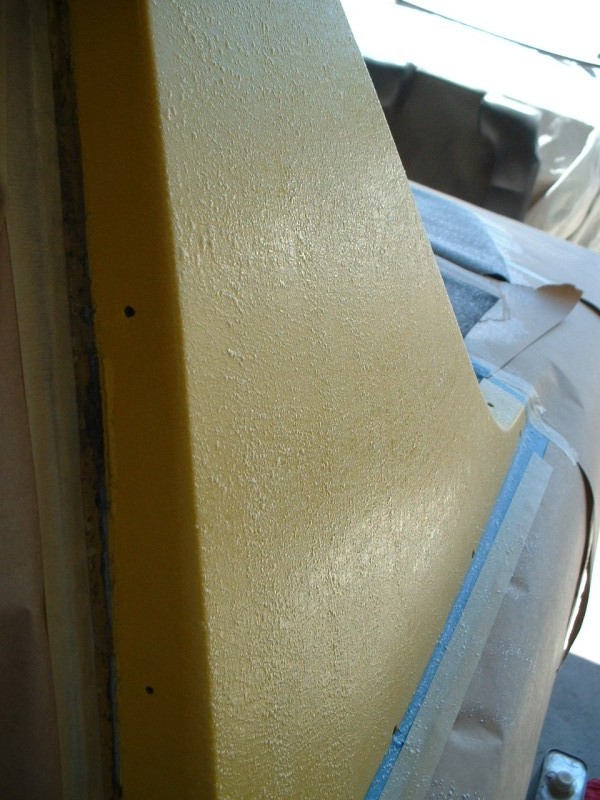
Adhesive
on the car.
Step 5: Laying Down the Vinyl
First you should remove the paper and tape that you had protecting the car. It will stick to the
back of your vinyl making the job impossible. Its job is done now anyway. The vinyl should be applied when each
surface is “tacky” to the touch (not dry like most contact adhesives) and this only takes 1-3 minutes. I set a
kitchen timer to 3 minutes. You should not let the surface sit for longer than 10 minutes before applying the
vinyl… meaning? You’ve got 7 minutes to get the job done. Start with the hoop top. As mentioned earlier I test
fit my vinyl before applying the adhesive. Knowing where I was going I actually laid the top piece over my head
and worked my way from the driver’s side to the passenger’s side however, it would probably be best to have a
helper hold this piece as you work it across. Concentrate on starting it straight and on the flat top surface
only. Once it’s down, press it smooth and then start rolling those edges down. Hurry, the clock is ticking. Lay
on the sidepieces by starting in the bottom corner by the handle. There’s a 45-deg. cut in the vinyl that should
straddle the edge of the panel. Hold the back of the vinyl out toward the rear of the car and make sure you will
be just covering your mounting holes for the lower trim piece. Smooth each one up and start working the edges
over. The major task is done.
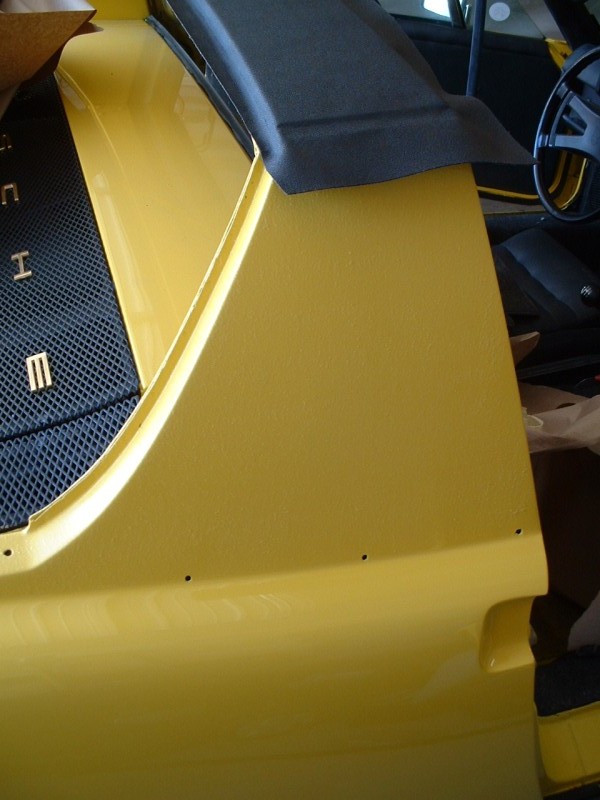
Top piece layed down
first.
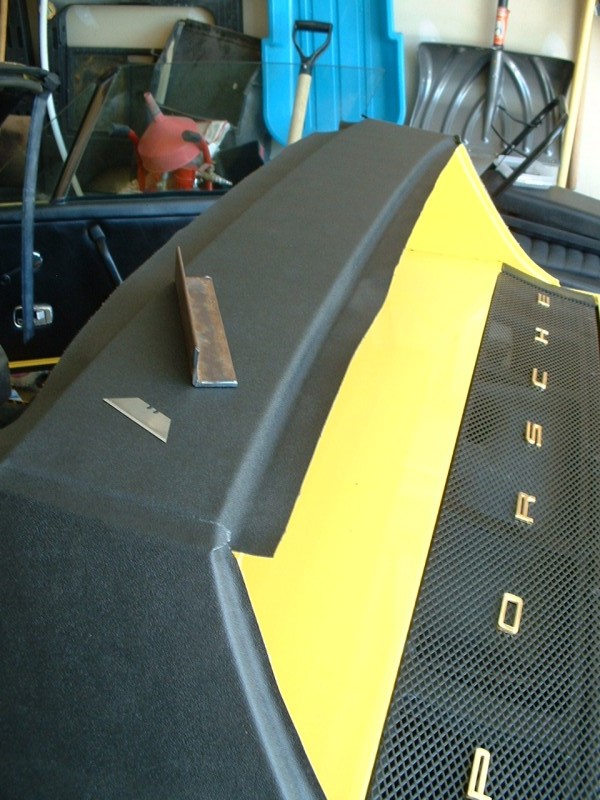
Sides
Ready to go.
Step 6: Trimming the Vinyl
Next you simply trim off any excess vinyl. Starting with the top piece. The factory ran a blade
along the base of each bend on the front and back of the hoop. I used a piece of angle iron to press the vinyl
into these dips in the metal. This little homemade tool worked great. If you decide to use this make sure there
are no sharp edges that would mar and cut the vinyl. A word about blades; keep them sharp. By cutting and
dragging across metal and heavy vinyl your blade will dull instantly. Feel free to change them after each long
cut or whenever they begin to show any sign of dulling. My first job, years ago, was hanging wallpaper
professionally. Trust me, a sharp blade is one of the most important things when working with industrial vinyl.
Trim the sides in a similar manner leaving the bottom for last. When trimming the bottom, you’ll want to test
fit the bottom trim piece (without the clips in it) and draw a line on the vinyl in pencil. The line should be
made “under” the trim piece on a portion of the vinyl that will be trimmed anyway. Remove the trim piece and cut
roughly 1/8” of an inch above your newly drawn line. This is “very” tricky and requires a patient hand and an
extremely sharp blade… better yet, a single-edged razor blade. You want to try to cut the vinyl only and not dig
into the paint. Water can gather here. Any slice through the paint and down to the bare metal will rust.
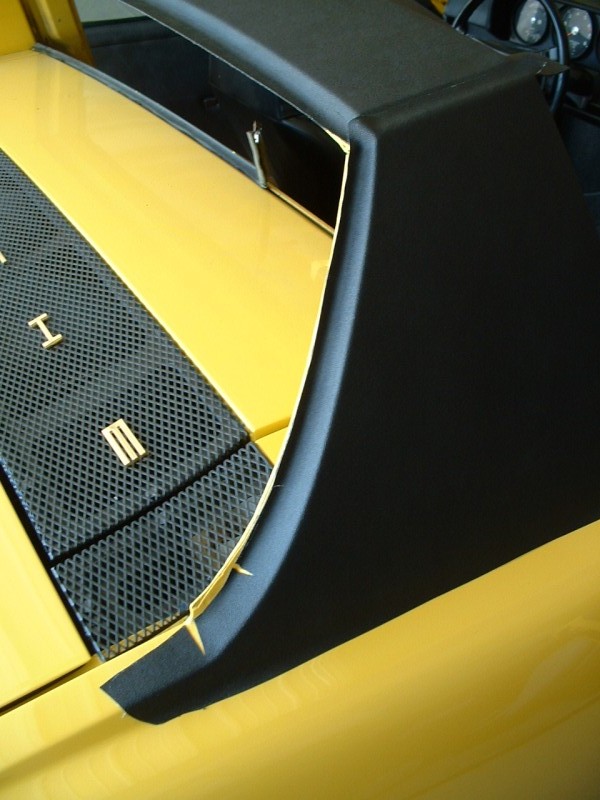
Small cuts help the vinyl
bend around the sail panel area.
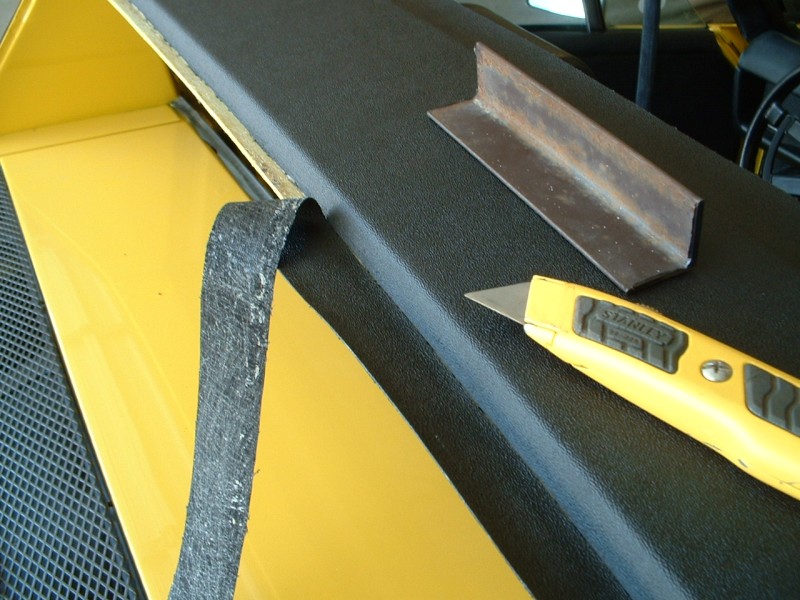
Trimming into the corners, use a
sharp blade.
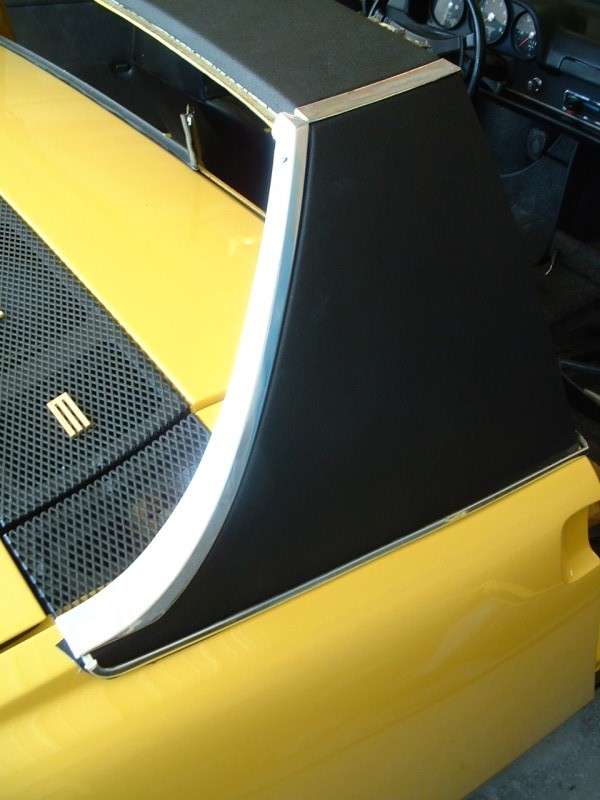
Final trial fit of the trim pieces
before cutting
Step 7: Put it all Back Together
To quote those famous repair manuals, “installation is the reverse of these steps”. As a final
tip, I use the spray silicon to help slide the window seals back into the trim pieces. Start putting it back
together and enjoy your new sail panels. I ended up biting the bullet and installing new metal trim pieces.
That took its toll on the wallet but the final result was stunning.
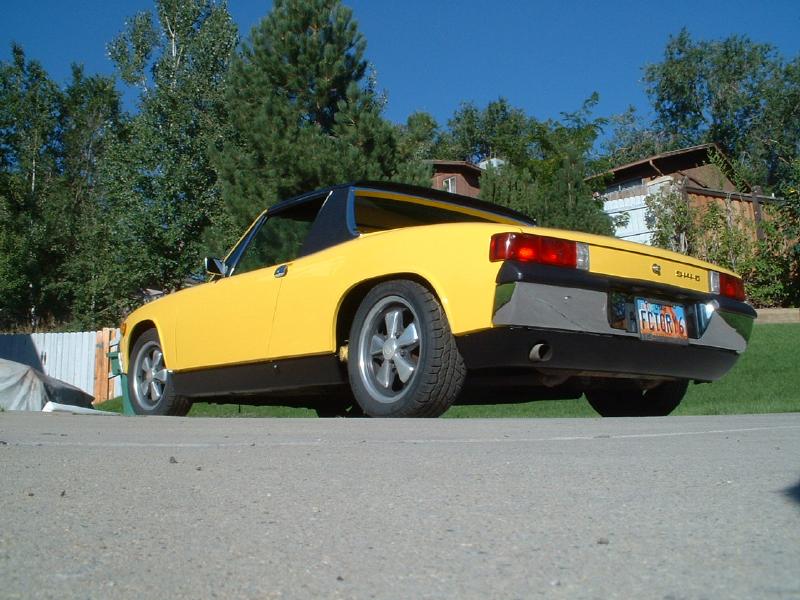
|
|
